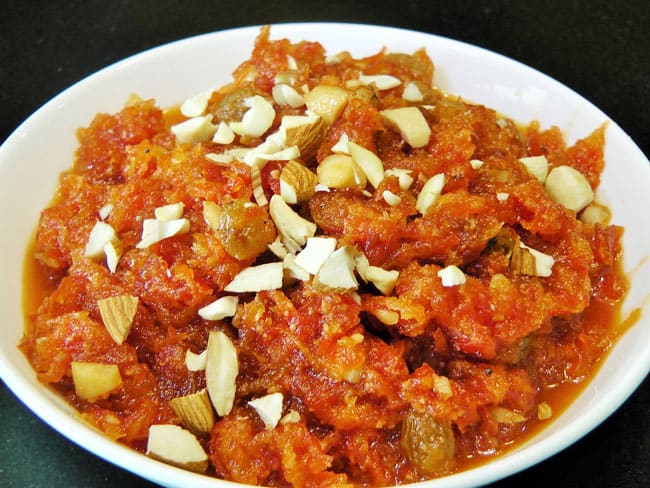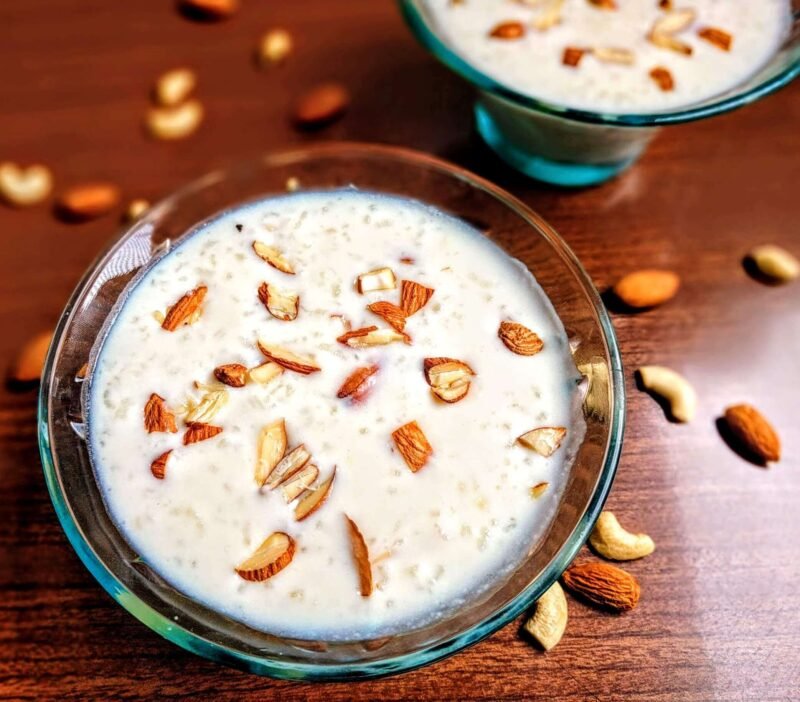The Quintessential Indian Dessert: Gajar Ka Halwa
Gajar Halwa Recipe: Gajar Halwa, also known as Gajar ka Halwa or “Gajrela,” stands as a testament to North Indian culinary mastery. This traditional dessert involves simmering freshly grated carrots in full-fat milk, sugar, and ghee. The result? A delectable treat infused with the fragrant essence of cardamom powder and adorned with a generous sprinkle of chopped nuts. In this article, we’ll explore the art of crafting this delightful Carrot Halwa through various methods, ensuring an exquisite experience for your taste buds.
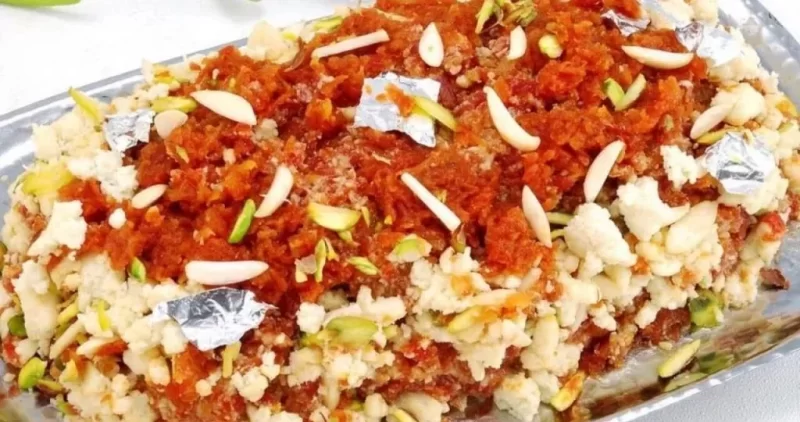
The Charm of Gajar Halwa
A Pudding Like No Other
Gajar Halwa, derived from the Hindi term for carrots, “Gajar,” and the sweet pudding, “Halwa,” is a classic Indian dessert. Unlike conventional puddings, this masterpiece doesn’t rely on eggs or thickening agents. Instead, it achieves its magical flavor and pudding-like texture through the slow cooking of carrots with milk until every drop evaporates.
The Delhi Gajar Twist
In India, the winter season brings forth Delhi gajar, a special carrot variety. Widely used in the North, these carrots impart a sweeter flavor and juicier texture to the Gajar Halwa. However, fear not if you can’t lay your hands on them; regular carrots work seamlessly in this recipe.
Crafting Gajar Halwa: Gajar Halwa Recipe
Traditional Method with Milk:
- Slow cook finely grated carrots with full-fat milk for an authentic, time-tested experience.
- Carrot Halwa with Condensed Milk (Under 15 mins):
- Opt for a quicker rendition by using condensed milk, resulting in a richer and flavorful outcome.
The Journey of Gajar Halwa Recipe: Step by Step
- Traditional Method with Milk
- Preparation
- Wash and finely grate 500 grams of carrots.
- On low heat, dry roast pistachios, almonds, and cashews until crunchy. Set aside.
- In the same pan, heat 2 cups of milk.
- Simmer Carrots with Milk
- Add grated carrots to the milk and stir. Cook on medium flame, stirring to prevent burning.
- Be cautious towards the end when the milk is nearly evaporated.
- Cook until the milk completely evaporates.
- Add half cup + 2 tablespoons of sugar and stir. Once gooey, add 1 tablespoon of ghee.
- Continue stirring until the halwa thickens. Finally, add half teaspoon of cardamom powder.
- Garnish with the roasted nuts and raisins. Serve chilled or warm.
- Gajar Ka Halwa with Condensed Milk
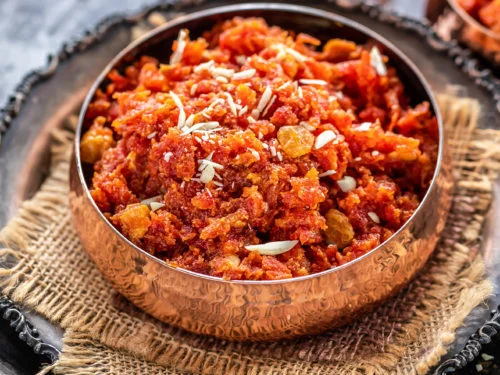
Ingredients
- 500 grams tender carrots
- ½ tin condensed milk (½ cup + 2 tablespoons)
- ¼ teaspoon cardamom powder or 1 teaspoon rose water
- 1½ tablespoons ghee (divided – ½ tablespoon + 1)
- ¼ cup chopped nuts (cashews, pistas, almonds)
- 2 tablespoons raisins
Instructions
- Wash and peel young carrots. Grate them using a food processor.
- Heat ½ tablespoon of ghee in a pan. Fry chopped nuts until golden and add raisins. Set aside.
- Add grated carrots to the pan and sauté for 2 to 3 minutes.
- Pour ½ tin condensed milk and mix. Cook until carrots release moisture.
- Cover and cook until carrots turn soft. Add cardamom powder.
- Enhance the aroma with 1 to 2 tablespoons of ghee. Mix until a delightful aroma emerges.
- Turn off the heat when the milk evaporates. Garnish with chopped nuts.
- Serve Gajar ka halwa warm or chilled.
Gajar Halwa with Khoya: A Quick Delight
Gajar Halwa Recipe with Khoya offers a swift alternative to the traditional version, utilizing less milk and reducing cooking time. Here’s a quick guide to this delightful rendition:
Ingredients
- ½ kg carrots (grated with a medium fine grater)
- ½ cup khoya (unsweetened)
- 1 cup milk
- ½ cup + 2 tablespoons sugar
- ½ teaspoon cardamom powder
Instructions
- Ensure the carrots are finely grated, as larger gratings won’t cook quickly in this method.
- Optionally, fry nuts and raisins in 1 tablespoon ghee. Add carrots and milk. Cook on low heat until carrots are tender. Cover and cook if needed.
- Add khoya and sugar. Mix and continue cooking until the mixture turns gooey. Let it cook until Gajar ka Halwa thickens.
- Add 1 tablespoon ghee, sauté for 2 minutes, turn off, and garnish with nuts and raisins.
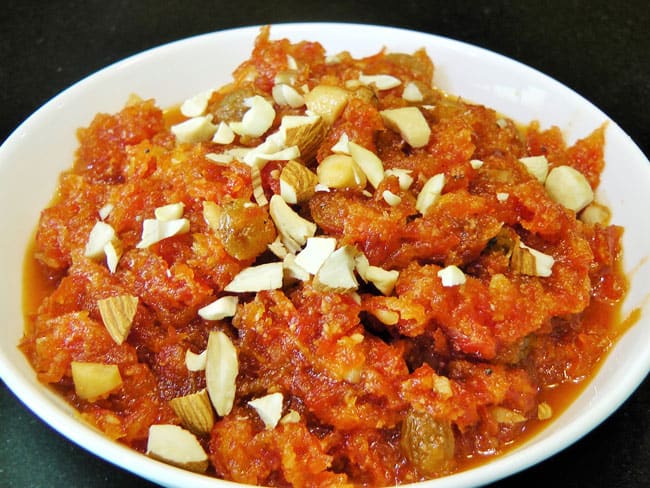
Gajar Ka Halwa with Milk Powder: A Sweet Symphony
Milk Powder lends a unique touch to Gajar Halwa, offering a different texture and taste. Here’s how you can whip up this version:
Ingredients
- ½ kg carrots (grated or fine processed)
- 1/3 cup milk
- ¾ to 1 cup milk powder
- 2 to 3 tablespoons ghee
- ¼ teaspoon cardamom powder
- 4 to 8 tablespoons sugar (adjust to taste)
- Chopped nuts as required
Instructions
- Add grated carrots to a heavy-bottomed pot or pressure cooker, pour milk, and cook until tender.
- Stir the carrots as they cook, then add sugar and continue cooking on low heat until slightly gooey.
- Sprinkle milk powder over the mixture, mix well, and cook until most of the moisture evaporates.
- Taste test and adjust sweetness with more milk powder or sugar.
- Add cardamom powder, turn off the heat, and serve with chopped nuts.
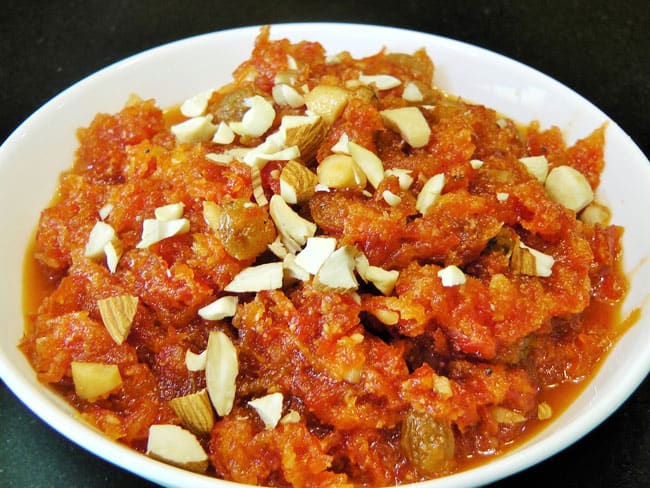
Instant Pot Carrot Halwa: Effortless Elegance
The Instant Pot brings ease to crafting Carrot Halwa without the constant stirring. Here’s a glimpse of this effortless rendition:
Pro Tips
- Choosing Carrots: Opt for fresh, tender, and young carrots for a mouth-melting halwa.
- Milk Choice: Use full-fat or whole milk for a tastier outcome. Adjust for a low-fat version or explore vegan alternatives like coconut or almond milk.
- Grating Carrots: Utilize a hand-held grater or a food processor for fine or thick shreds based on preference.
Sautéing carrots can be expedited by skipping the initial sautéing step. Instead, introduce ghee later in the cooking process to enhance and intensify the flavor.
When preparing Gajar Halwa, exercise caution to prevent scorching or burning of the milk. It is imperative to avoid leaving the halwa unattended, emphasizing the importance of constant stirring.
Explore the diverse world of Gajar Halwa, where each variation offers a distinctive symphony of flavors and textures. Whether you opt for the quick Khoya version, the milk powder twist, or the convenient Instant Pot rendition, the outcome is a culinary masterpiece that captivates the senses. Embark on this delightful journey and relish the magic of Gajar Halwa in its various forms.
In conclusion, Gajar Halwa Recipe transcends being merely a dessert; it is an immersive experience that encapsulates the essence of Indian winters and festive celebrations. Whether you choose the traditional slow-cooked method or opt for the condensed milk shortcut, the result is a sweet symphony that delights the senses. Immerse yourself in the Gajar Halwa Extravaganza and let your taste buds revel in the timeless magic of this treat.
FAQs about Gajar Ka Halwa:
What makes Gajar Ka Halwa unique among Indian desserts?
Gajar Ka Halwa is distinct for its rich flavor and pudding-like texture achieved without eggs or thickening agents. It showcases North Indian culinary mastery by slow-cooking grated carrots in full-fat milk, sugar, and ghee, infused with cardamom powder and adorned with chopped nuts.
Can I use regular carrots if Delhi gajar is not available?
Yes, regular carrots work seamlessly in the Gajar Halwa recipe if Delhi gajar, a special variety known for its sweeter flavor and juicier texture, is unavailable.
What are the different methods to prepare Gajar Halwa?
There are four distinct methods to prepare Gajar Halwa:
- Traditional Method with Milk
- Gajar Halwa with Condensed Milk (Under 15 mins)
- Gajar Halwa with Khoya
- Gajar Ka Halwa with Milk Powder
- How do I choose the right carrots for Gajar Halwa?
Opt for fresh, tender, and young carrots for a mouth-melting Gajar Halwa. Grate them finely using a hand-held grater or a food processor based on your preference.
Can I make Gajar Halwa in an Instant Pot?
Yes, an Instant Pot can be used to make Gajar Halwa, providing an effortless alternative without constant stirring. Ensure to exercise caution to prevent scorching or burning of the milk during the cooking process.

